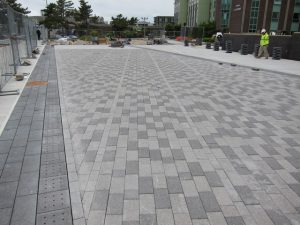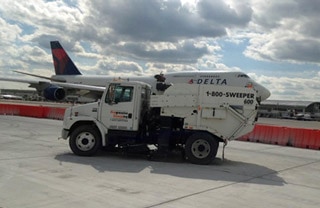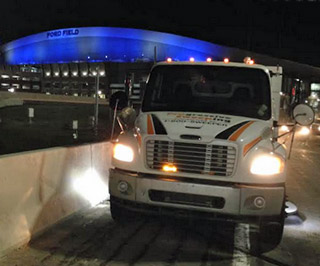 To provide our Partner companies with some background on permeable pavement and a Best Management Practice (BMP) checklist for the care and maintenance of pervious pavement areas, we requested assistance from 1-800-SWEEPER Board Member, Gerry Kesselring. Gerry previously participated in a day-long workshop/conference along with Ohio Department of Natural Resources, National Ready Mix Concrete Association, Interlocking Concrete Pavement Institute, and Flexible Pavements of Ohio.
To provide our Partner companies with some background on permeable pavement and a Best Management Practice (BMP) checklist for the care and maintenance of pervious pavement areas, we requested assistance from 1-800-SWEEPER Board Member, Gerry Kesselring. Gerry previously participated in a day-long workshop/conference along with Ohio Department of Natural Resources, National Ready Mix Concrete Association, Interlocking Concrete Pavement Institute, and Flexible Pavements of Ohio.
The workshop provided an opportunity for material suppliers, construction inspectors, local agency employees and contractors involved in stormwater management (CPESC, CESSWI, CMS4S & CPSWQ) to learn recommended design, inspection and maintenance of permeable pavement as a part of long-lasting stormwater management pavement surfaces.
Permeable Pavement Background
Pervious paving, also called porous paving, gap-graded paving, permeable paving, or enhanced porosity paving, is increasingly being used as part of a stormwater management design to reduce stormwater runoff and replenish aquifers.
As pavement maintenance professionals, most concrete and asphalt paving that we encounter is produced from dense mixes of well-graded aggregate sizes that interlock with each other, making a stable low-porosity mass. This traditionally formulated paving is designed to shed rather than absorb water.
The American Standard for Testing and Materials (ASTM) defines a porous (permeable) pavement as “one with porosity and permeability high enough to allow water to readily pass and thus significantly influence hydrology, rooting habitat, and other positive environmental effects.” Stormwater can flow through pervious paving into the ground underneath ultimately infiltrating subgrade soils and re-entering the aquifer.
Pervious paving uses an open-graded aggregate mix with a large percentage of one-sized coarse aggregate, also called gap-graded or uniformly graded aggregate.
ASTM C 1701 is a test used to determine permeability. We have developed and made available an interactive calculator to assist in determining porous pavement permeability.
Special considerations for heavily sloped areas
While associated with the design of paved areas rather than the maintenance of these areas, it is important for power sweeping professionals to appreciate the affect proper slope has on collection of dirt and fine aggregates that can block water entry into permeable paving.
Paving is typically sloped away from buildings, retaining walls, and other elements capable of collecting surface water. Traditional exterior paving is usually sloped at least 1/4 inch per foot (2{cd9db56748df391b131010c0c880113f42d56e29626b6ebf74877cbc020d5b1a}.)
Porous pavers may be sloped as little as 1/8 inch per foot (1{cd9db56748df391b131010c0c880113f42d56e29626b6ebf74877cbc020d5b1a}) because water is assumed to not be diverted into sewers or retaining ponds, etc.
During heavy storms, if the rainwater cannot infiltrate the paving as fast as it falls, water will flow down a graded slope designed so water does not build up on the surface. Too steep a slope however in porous pavement should be avoided. If heavy rainfall consistently flows water to a “low point” in otherwise permeable pavement, water carries fines to a single, consistent area. This creates the highest concentration of blockage at the very place water is meant to absorb after running downhill.
Proper Maintenance Practice for Porous Pavement Areas
Maintenance of permeable pavement requires sweeping at least 12 times a year in moderate climates, less frequently in areas that receive significant snowfall in winter. Depending on the potential for clogging caused by vegetation, garbage, and traffic among other reasons, more frequent sweeping of porous pavements may be required.
The best method to perform regular preventative maintenance of these surfaces is to perform testing of drainage through the system on a schedule that would identify the point in which clogging occurs and structure a maintenance schedule accordingly.
The best choice for equipment to be used to clean permeable pavement is a regenerative air sweeper. Regenerative air sweepers blast air down and clean deeper to better lift silt and other materials from the holes and provide the necessary transfer and pickup actions to far more completely clean the surface. For best results, properly adjust the sweeping head to reduce potential seal loss and, before all cleanings, adjust the rubber skirt according to manufacturer’s guidelines to ensure the most thorough porous pavement cleaning/maintenance. In addition, the leaf bleeder should be closed to allow for the air blast across entire width of pick-up head.
Avoiding Use of Brooms
The use of any machine which requires brooms should be avoided. In this application, brooms could loosen more aggregate which could then be forced into the engineered porosity within the pavement which will lead to more in-depth maintenance being required. If a regenerative sweeper is not available and a standard vacuum sweeper is used, it is imperative that the suction head sweep the entire surface area. A spotter may be required to make sure that there is proper overlap of the suction head.
When sweeping permeable pavement, special attention should be given to low points of the surface. In these areas, it may be necessary for the operator to “sit” with the pickup head over the depression in the surface.
The recommended speed of the sweeper is less than 5 mph. To set up the sweeper properly, make a test pass to determine the level of throttle that can be used to remove debris while disturbing the least amount of media.
If the pavement is significantly plugged and removal of the media from the clogged areas is desired, increase the level of throttle and create a larger air blast. If sweeping a parking lot or a curbed area, the edges and corners of the surface should be blown to the center. It’s critical that the entire surface area be swept under the head of the regenerative air sweeper.
Pavement Rejuvenation
Because paving structures that absorb or allow passage of water are sophisticated systems, care must be taken in their design, detailing, and construction. If subgrades do not drain quickly enough under cold conditions, trapped water may freeze and damage paving. In times when there is heavy rainfall, if the intended flow rate is impeded because of built-up silt or other fine particulates flooding can easily occur. Therefore, surface and subsurface drainage is of major importance.
If during pre-sweep testing, it is found that the flow rate of the surface is so poor that sweeping is no longer effective then a rejuvenation process should be undertaken.
Rejuvenation will require power washing the surface with a “deck/flat surface” type cleaner that has been modified to be “vacuumized.” Hand-held hoses connected to sweepers or sewer trucks may be used to provide the suction for a “deck/flat surface cleaner.”
Of course, different environments and specific situations will dictate variations in this maintenance BMP methodology.
It is important however, that 1-800-SWEEPER Partners are familiar with the basic methods of cleaning permeable pavement and can educate our customers to proper maintenance requirements. This is yet another value that our Partners can offer. If you have questions, or wish to further develop this topic, please post on the private 1-800-SWEEPER Partners Linkedin page.



